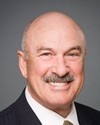Yes, I can. Thank you for the question.
The main reason for the new stamp—and as you are probably aware, the legislation to implement the new stamp is before the House right now, as part of the budget implementation act, C-9—was clearly to deal with the counterfeit that we're seeing coming in from the outside.
The current regime deals with tear tape. This is a sheet of tear tape, with different colours to match with the different provinces. The tear tape says, on the yellow one, “Droit Acquitté—Ontario—Canada Duty Paid”. This tear tape is available to whoever wants to produce it. There are no security features. It's very easy for an illegal manufacturer to avail itself of this.
The reason we're going to the stamp—and what I have here is a bigger version of what is not quite that big—is that it has a number of overt and covert security features. We've done a number of studies. We've done a lot of research before adapting this and going through a request for proposal to give out a contract, which has been given out to Canadian Bank Note in partnership with SICPA, which is a Swiss company that specializes in invisible ink and also specializes in a number of projects around the world with a similar stamp. Their stamps have never been counterfeited. There's a sequential number on it. Each pack will have its sequential number, which allows us to know where the product comes from, if it's seized outside its jurisdiction.
In terms of benefit, clearly there's a CRA or a government benefit in getting the stamp. CRA is going to have an order desk. We're going to be looking at an accountability regime for the stamp linked to the production of each company or importer, linked to the duties they pay, and with all of this will be making a decision as to whether we allow the provider of the stamps to release them to the manufacturers or not.
Thank you.




